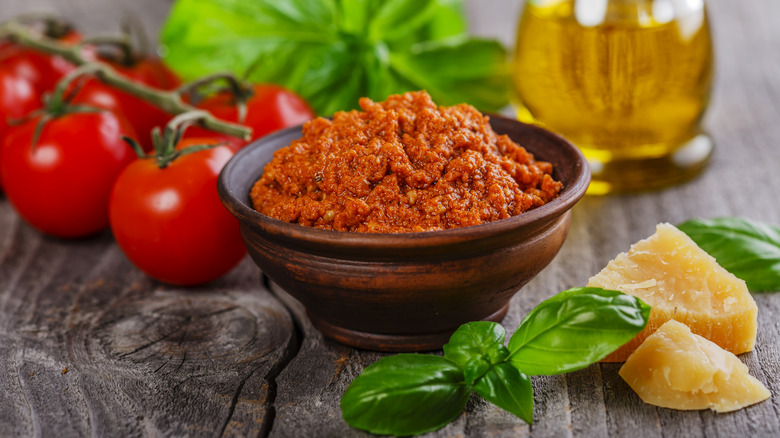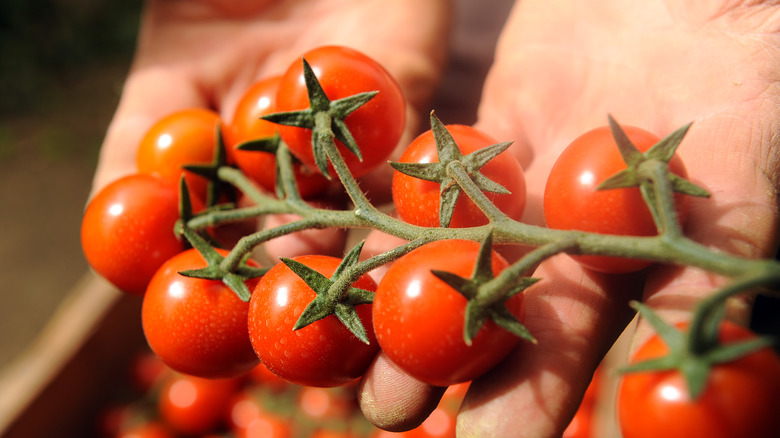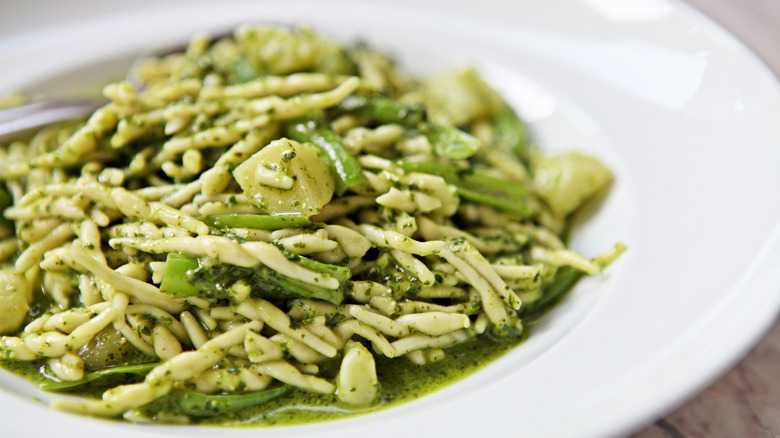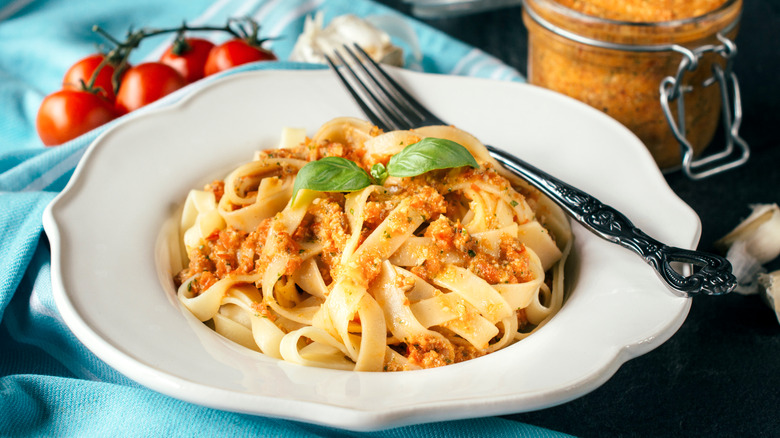What Is Pesto Alla Trapanese And How Does It Differ From Classic Basil Pesto
When you think of pesto, you're probably thinking of the classic green sauce made with basil, olive oil, pine nuts, garlic, and lemon. This traditional version, known as pesto Genovese, comes from the Liguria region in northern Italy. And while this type is undoubtedly the most popular today in the U.S., different regions in Italy have adopted their own version of the sauce — and it doesn't always have to be green.
For example, Calabrians make pesto alla calabrese, which features roasted red peppers and black pepper, while gremolata uses parsley, breadcrumbs, and anchovies. The word "pesto" comes from the Genoese word "pestare," which means to crush. So technically, any paste that involves crushing ingredients, traditionally with a mortar and pestle, may qualify as pesto in Italian terms.
If you venture to the Italian province of Trapani, you may get the chance to try pesto alla trapanese, the region's spin on the spread. But what ingredients are the Trapanese crushing in their pesto? Let's find out.
Where does pesto alla trapanese come from?
If you've never tried pesto alla trapanese, or agghiata trapanisa, that may be because most travelers visiting Italy don't venture to the town of Trapani. Located on the island of Sicily, Trapani is a religious seaside town and the capital of the province of Trapani. Pesto alla trapanese was born when traders from Genoa (aka where traditional basil pesto comes from) traveled to Trapanese ports and traded with the locals.
Genoese sailors, who were on their way further East, introduced the Sicilians to their green pesto, which the locals adapted using ingredients from their town. Not only did the Trapanese learn about new ingredients like basil, but they were also taught the northern Italian method of pulverizing them into a paste. There is another version of the story, however — according to food writer Rachel Roddy, the Genoese sailors were actually the ones to make the Sicilian pesto when they were stationed in Trapani and only had local ingredients available (via The Clever Carrot).
Either way, we know that the sauce was a mashup of regional pesto, and pesto alla trapanese still has a firm foothold in Sicilian gastronomy. It's commonly eaten with busiate, a variety of western Sicilian pasta that is long and spun into a shape ideal for holding sauce in its crevices. In fact, the Italian Ministry of Agricultural, Food, and Forestry Policies lists "busiati col pesto trapanese" as a national, traditional food product.
How do you make pesto alla trapanese?
Pesto alla trapanese uses plenty of the same ingredients as Genovese pesto — namely, basil, garlic, Parmigiano Reggiano or Pecorino, olive oil, and salt. However, the pine nuts get swapped out for almonds, a quintessential Sicilian nut. Today, Sicily produces a whopping 80% of Italy's almonds, and they celebrate the nut by incorporating it in various desserts and honoring it in the annual Festival of Almond Blossom.
The other ingredients that make pesto alla trapanese unique are cherry tomatoes — specifically, the Pachino tomato variety, which grows plentifully in Sicily and closely resembles what we consider to be cherry tomatoes in the U.S. Some recipes call for adding mint instead of, or alongside basil, while others leave the mint out altogether. As with most Italian cooking, the key here is to procure the freshest ingredients possible for optimal flavor.
The traditional version of the sauce is made using a mortar and pestle to crush the ingredients together. But first, the almonds need to be blanched so their skins can be removed, and the tomatoes need to be peeled and seeded. Then, the garlic and salt get pulverized together to form a paste, followed by all the other ingredients. If you don't own a mortar and pestle, you can combine the ingredients in a food processor for a similar effect, but don't blend everything too thoroughly to ensure the basil retains its bright color.
Pesto alla trapanese vs. pesto alla genovese
The authentic version of pesto alla genovese is made with Genovese basil D.O.P (which stands for Protected Designation of Origin in Italian), extra virgin olive oil (preferably from the region of Liguria), Parmigiano Reggiano or grana padano, Pecorino, pine nuts, garlic, and salt. The Consortium of Genoese Pesto, an organization that focuses on preserving this traditional recipe, details a few key guidelines for making pesto alla genovese: One clove of garlic must be used for every 30 basil leaves, the garlic must be sweet but not overpowering, and the whole thing should be made at room temperature to avoid oxidizing. Lastly, the traditional mortar and pestle method is preferred over blenders or food processors.
The technique for making pesto alla trapanese is pretty much the same, although the ingredients reflect Sicilian foods, leaving certified Genovese basil and pine nuts out of the equation. Since pesto alla trapanese can be considered a spin-off of the genovese version, the latter came first. Back in the Middle Ages, garlic was prized in Liguria because sailors believed it could help prevent illness, and ancient Romans used it to make a spread with walnuts. Then in 1865, a cookbook called "La Cuciniera Genovese" published the first-ever recipe for pesto alla genovese. Since it was a staple for sailors at the time, its popularity began to spread worldwide — including to Trapani, where it inspired pesto alla trapanese.
What can you eat with pesto alla trapanese?
If you want to eat pesto alla trapanese as the Sicilians do, try mixing it in with busiate and topping it with grated cheese or breadcrumbs for a classic, Italian government-approved dish. However, that's not the only purpose this fresh summer pesto can have; it also works well with any other type of pasta that can hold sauce, such as penne or fusilli. And you can get a little creative with the toppings if you'd like — for example, Nigella Lawson's recipe for Sicilian pasta with tomatoes, garlic, and almonds incorporates anchovies, capers, and golden raisins. You could also try adding a protein like chicken, fish, or pork.
Once you've had your fill of pasta, don't throw out any extra pesto. You can essentially use this sauce the way you would use the traditional basil version — try spreading it on bread, incorporating it into a sandwich, dipping breadsticks and veggies in it, or adding a dollop on top of a salad. It would also make a delicious ingredient in a grilled cheese sandwich or on top of chicken or pizza. Keep in mind, of course, that the flavor will lean more toward tomato and will differ quite a bit from traditional green pesto, but it won't be any less tasty.




